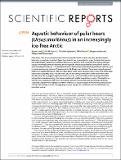Files in this item
Aquatic behaviour of polar bears (Ursus maritimus) in an increasingly ice-free Arctic
Item metadata
| dc.contributor.author | Lone, Karen | |
| dc.contributor.author | Kovacs, Kit M. | |
| dc.contributor.author | Lydersen, Christian | |
| dc.contributor.author | Fedak, Mike | |
| dc.contributor.author | Andersen, Magnus | |
| dc.contributor.author | Lovell, Philip | |
| dc.contributor.author | Aars, Jon | |
| dc.date.accessioned | 2018-07-12T12:30:10Z | |
| dc.date.available | 2018-07-12T12:30:10Z | |
| dc.date.issued | 2018-12-01 | |
| dc.identifier | 254679413 | |
| dc.identifier | 749f6c0a-b2bf-4ae2-b0cb-c67769e08c7d | |
| dc.identifier | 85049259923 | |
| dc.identifier | 000436233600005 | |
| dc.identifier.citation | Lone , K , Kovacs , K M , Lydersen , C , Fedak , M , Andersen , M , Lovell , P & Aars , J 2018 , ' Aquatic behaviour of polar bears (Ursus maritimus) in an increasingly ice-free Arctic ' , Scientific Reports , vol. 8 , 9677 . https://doi.org/10.1038/s41598-018-27947-4 | en |
| dc.identifier.issn | 2045-2322 | |
| dc.identifier.other | ORCID: /0000-0002-9569-1128/work/47136238 | |
| dc.identifier.uri | https://hdl.handle.net/10023/15306 | |
| dc.description | This study was funded by Statoil and the Norwegian Polar Institute’s ICE Centre. The Norwegian Polar Institute, WWF and various NRC projects have also contributed to the base-line capture-recapture programme that financed telemetric deployments. | en |
| dc.description.abstract | Polar bears are ice-associated marine mammals that are known to swim and dive, yet their aquatic behaviour is poorly documented. Reductions in Arctic sea ice are clearly a major threat to this species, but understanding polar bears' potential behavioural plasticity with respect to the ongoing changes requires knowledge of their swimming and diving skills. This study quantified time spent in water by adult female polar bears (n = 57) via deployment of various instruments bearing saltwater switches, and in some case pressure sensors (79 deployments, 64.8 bear-years of data). There were marked seasonal patterns in aquatic behaviour, with more time spent in the water during summer, when 75% of the polar bears swam daily (May-July). Females with cubs-of-the-year spent less time in the water than other females from den emergence (April) until mid-summer, consistent with small cubs being vulnerable to hypothermia and drowning. Some bears undertook notable long-distance-swims. Dive depths up to 13.9 m were recorded, with dives ≥5 m being common. The considerable swimming and diving capacities of polar bears might provide them with tools to exploit aquatic environments previously not utilized. This is likely to be increasingly important to the species' survival in an Arctic with little or no persistent sea ice. | |
| dc.format.extent | 12 | |
| dc.format.extent | 3565422 | |
| dc.language.iso | eng | |
| dc.relation.ispartof | Scientific Reports | en |
| dc.subject | QH301 Biology | en |
| dc.subject | DAS | en |
| dc.subject | SDG 14 - Life Below Water | en |
| dc.subject.lcc | QH301 | en |
| dc.title | Aquatic behaviour of polar bears (Ursus maritimus) in an increasingly ice-free Arctic | en |
| dc.type | Journal article | en |
| dc.contributor.institution | University of St Andrews. School of Biology | en |
| dc.contributor.institution | University of St Andrews. Scottish Oceans Institute | en |
| dc.contributor.institution | University of St Andrews. Marine Alliance for Science & Technology Scotland | en |
| dc.identifier.doi | 10.1038/s41598-018-27947-4 | |
| dc.description.status | Peer reviewed | en |
This item appears in the following Collection(s)
Items in the St Andrews Research Repository are protected by copyright, with all rights reserved, unless otherwise indicated.

